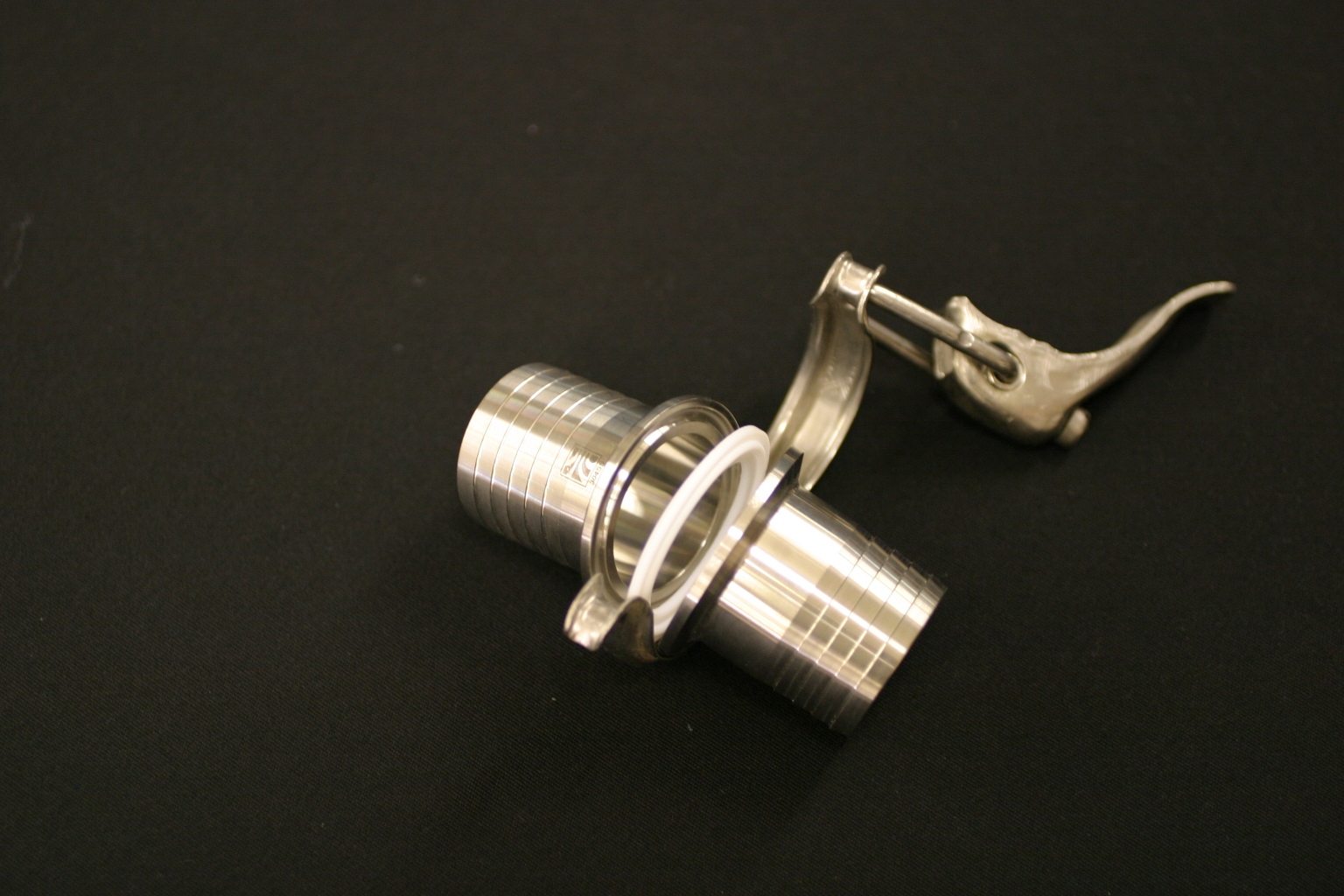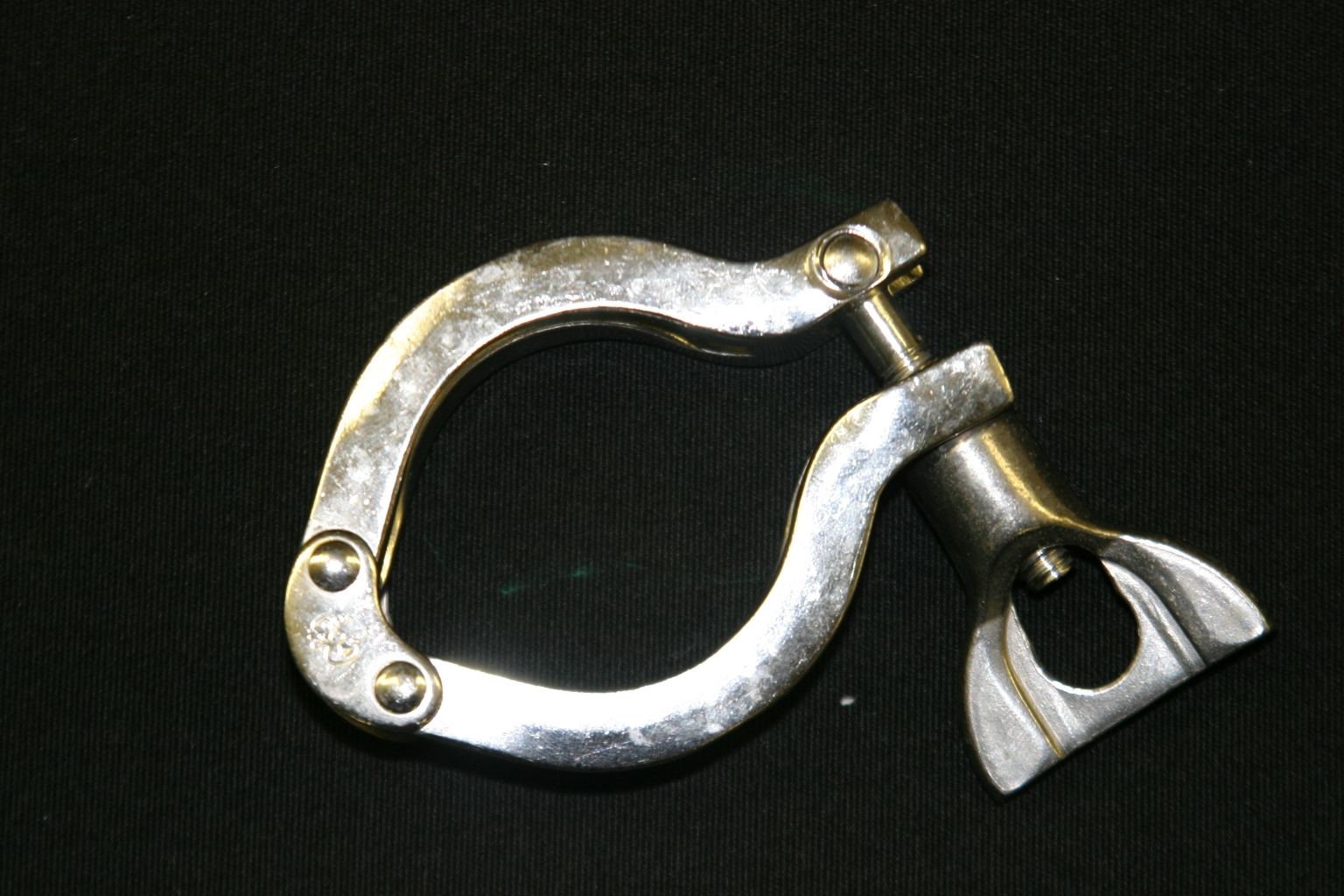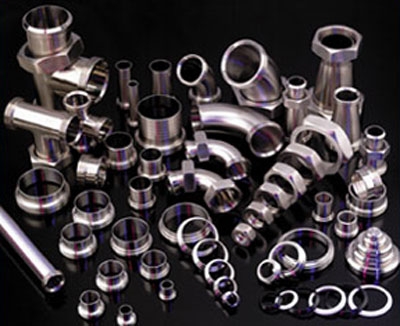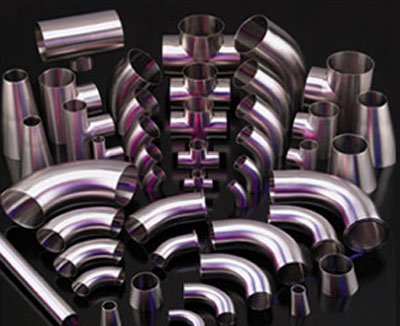Sanitary Fittings and Tubing for Food Processors
Introduction
Sanitary tubing and fitting types (referred to collectively as “piping”) and the standards that regulate their use have evolved over the years by trial and improvement. Consequently, a great variety of sanitary piping and standards are in use today. This fact sheet briefly explains the most common sanitary piping and standards and how they are applied. A section with sources of sanitary piping materials is also included.
Materials
Stainless steel is the most common material used in sanitary piping. This metal has the advantage of cost, corrosion resistance and durability, relative to other materials. Table 1 shows some of the grades of stainless steel and their description. In general, the higher the grade, the better the corrosion resistance. Price increases with grade.
Table 1. Selected grades of stainless steel with brief descriptions.
| Grade | Description |
|---|---|
| 303 | Free machining variation of 304. Corrosion resistant to most foods and cleaners. |
| 304 | Excellent resistance to a wide range of foods and cleaning solutions. |
| 304L | Low carbon variation of 304. Avoids harmful carbide precipitation during welding. |
| 316 | Added molybdenum offers better corrosion and pitting resistance plus higher strength at elevated temperatures (a 316L version is also available) |
| AL - 6XN | Super austenitic stainless designed to resist crevice corrosion, pitting and chloride-induced corrosion and stress corrosion cracking. This grade of stainless still is especially useful for applications such as sports drinks. |
Surface finish
Description of surface finish of stainless steel components is often confusing, since different reference scales are commonly used, depending upon industry and custom. Two of the most important scales used to measure surface roughness are: Ra and grit. Ra is the “roughness average” specified in the ANSI/ASME standard B46.1 -1985. The Ra value relates to an arithmetic average of the surface roughness as measured by the stylus motion of an instrument. For comparative purposes, an Ra of 4 corresponds to a “mirror” finish. In the dairy and food industry, surface finishes have traditionally been measured by grit. Grit is the number of abrasive grains per given area. The higher the grit number, the smoother the finish (similar to traditional sand-paper). Table 2 gives a guide for comparison of Ra and grit finish measurements. Comparison of grit to Ra finish is not exact and requires consideration of variable elements such as polishing equipment, materials and technique.
Table 2. Guide to comparison of grit finish and Ra (micro-inch) measurements.
| Grit | Ra (Range, micro-inch) |
|---|---|
| 150 | 30-35 |
| 180 | 20-25 |
| 240 | 15-20 |
| 320 | 9-11 |
Electro-polishing is a finishing technique that results in a smooth surface due to a chemical-electrical treatment that is most often applied after mechanical polishing steps. Electro-polished piping usually carries the initials “EP” and has a superior, mirror-like finish.
Product piping is polished on the inside, as a minimum, since the product-contact surface should be smooth to prevent attachment of soils and microorganisms. Polished finishes on the outside of piping are normally specified for appearance or to facilitate cleaning. Piping surfaces that are covered with insulation are often specified as unpolished. Industrial grade (mill finish) piping is frequently used for potable water, cleaning solutions or other applications where soil residues and microbial levels are low. Table 3 describes industry standard finish numbers commonly used for food and dairy tubing.
Table 3. Finish number and description for sanitary tubing.
| 1 | Industrial (mill finish) |
|---|---|
| 3 | Sanitary (ID polished to #150 grit or 32 Ra, OD mill finish |
| 5 | Industrial (ID mill finish, OD polish to #150 grit or 32 Ra |
| 7 | Sanitary (ID and OD polished to #150 grit or 32 Ra) |
Sanitary Tubing
Fortunately, the wide acceptance of seamless stainless steel tubing and standardization within the metals fabrication industry has simplified tube selection. Outside diameter and gage is used to specify sanitary tubing. Sixteen-gage tubing is used for the vast majority of applications, except those with large-diameter and/or higher product pressures. Specifications for sanitary tubing are shown in table 4. Tubing is manufactured according to ASTM A270 “Specification for Seamless and Welded Austenitic Steel Sanitary Tubing.”
Table 4. Specifications of sanitary tubing.
| OD | Gage | Wall Thickness | ID | Volume (gal/100 ft) | Dry weight (lbs/100 ft) | Flow capacity (ppm) fps |
|---|---|---|---|---|---|---|
| 1.5" | 16 | 0.065 | 1.37 | 7.66 | 100.9 | 23 |
| 2" | 16 | 0.065 | 1.87 | 14.27 | 136.1 | 43 |
| 2.5" | 16 | 0.065 | 2.37 | 22.92 | 171.2 | 69 |
| 3" | 16 | 0.065 | 2.87 | 33.6 | 206.4 | 101 |
| 4" | 14 | 0.083 | 3.83 | 59.97 | 351.8 | 180 |
| 6" | 12 | 0.109 | 5.78 | 136.39 | 694.7 | 409 |
| 8" | 12 | 0.109 | 7.78 | 247.07 | 930.6 | 741 |
Sanitary Pipeline Fittings are manufactured by a long list of companies utilizing a number of joint styles and sealing techniques including (in no particular order): Tri-Clamp or “clamp,” Butt-weld, Bevel Seat, DC, H-Line, HDI-Line, John Perry, S-Line, and I-line. Fitting types have been developed specifically for certain industries, manufacturers and user groups. Adaptors to connect different types of fittings are sometimes available, as well as adaptors to connect fittings to non-sanitary piping such as flanges, pipe thread, pipe OD (compression fitting) and other items. The system designer must select carefully, especially when mating new piping to existing piping and equipment.
In Oklahoma, clamp (figure 1) and bevel seat (figure 2) fittings are the most common for systems that require frequent disassembly. Butt-weld fittings (figure 3) are used for permanent piping systems. Hygienic design and sanitation standards for sanitary fittings and pipeline have been developed by and are available from the 3-A Sanitary Standards Institute (McLean, Va.). Fittings that have been manufactured according to the 3-A specifications and standards bear the 3-A symbol and are accepted nationwide by health inspectors. Sanitary fittings conform to an identification system based on numbers, with examples given in table 5.

Figure 1a. Disassembled clamp fitting, clamp and gasket

Figure 1b. Disassembled clamps

Figure 2. Bevel seat fittings

Figure 3. Butt-weld fittings
Table 5. Selected identification numbers of sanitary fittings.
| Fitting | Identification Number |
|---|---|
| Elbows: 90°, 45° | 2 |
| Tees | 7 |
| Crosses | 9 |
| Clamps, Hex union nuts | 13 |
| Ferrules, adapters | 14 |
| End caps | 16 |
| Concentric reducers | 31 |
| Eccentric reducers | 32 |
| 2 way plug valve, butterfly valves | 10 |
| 3 way plug valve, butterfly valves | 11 |
| Check valves | 45 |
| Misc. fittings (wrenches, hangers) | 25 |
| Adapters | 22 |
| Wall plate | 29 |
Food-Grade Gasket Materials
As specified by the 3-A standards, food-grade rubber and plastic material can be used for gaskets in sanitary joints. Table 6 lists selected 3-A approved commercial gasket materials and their working temperature range.
Table 6. Selected list of approved gasket materials and their operating temperature range.
| Temperature range, F | ||
|---|---|---|
| Gasket Material | Minimum | Maximum |
| Buna-N (black or white) | -40 | 225 |
| Teflon® (PTFE) | -110 | 400 |
| Silicon | -20 | 450 |
| Viton (flourel) | -20 | 450 |
| EPDM | -55 | 275 |
Pipeline Installation
Extreme care and planning must be considered before installation of sanitary pipelines. Professional help should be employed when possible. Installed cost of stainless piping can run from $30 to more than $300 per foot, depending upon many factors. Orbital welding techniques are used to join pipe fittings to tubes or equipment as necessary. Inert gas is employed to prevent weld contamination. Subsequent polishing steps may be necessary, depending upon welding methods selected. Pipeline installation mistakes and rework are costly. Some installation tips follow:
- Begin your project with a drawing (three-dimensional if possible) and include clearance areas for operations, cleaning and maintenance activities.
- Design to minimize piping, valves, joints and fittings.
- Slope lines to facilitate self-draining.
- Support piping at ample locations, considering thermal expansion and dynamic product loads.
- Potable water lines connected directly to sanitary tubing are a violation of plumbing code; lines must be isolated with a physical “air gap.”
- Use check valves and vacuum breakers in steam lines connected to sanitary tubing or cook vessels to prevent product “suck-back.”
- Eliminate dead legs that contain stagnant product in process lines.
- Use flexible connections (hose) at pumps, tanks and other devices that may be moved or frequently disconnected.
- Install quick-release fittings to facilitate cleaning and inspection.
- Insulate only when necessary to prevent operator injury or to protect product.
- Costs of installed piping systems can be dramatically reduced by prefabrication at an outside shop. Use of clamp fittings will facilitate shipping and eliminate or reduce the number of costly on-site welds needed. Warning–precise dimensions and specifications are required!
Summary
Sanitary piping systems are an important part of many food processing operations. When designed, fabricated and installed correctly, they require minimal attention and help to maintain product quality and integrity. Awareness of the great variety of fittings, materials, type and sizes of components available will help during the selection and installation of any sanitary piping system.
Select Sources of Sanitary Tubing and Fittings
National distributors/manufacturers
Alfa Laval
8201 104th Street
Pleasant Prairie, WI 53158
800-558-4060
Robert-James Sales, Inc.
PO Box 7999
2585 Walden Ave.
Buffalo, NY 14225
800-666-0088
Top Line Process Equipment
P.O. Box 264
Bradford, PA 16701
800-458-6095
Waukesha Cherry-Burrell
611 Sugar Creek Road
Delavan, WI 53115
800-252-5200
SwageLock
Tulsa Valve & Fitting Co.
1815 West Detroit
Broken Arrow, OK 74012
918-258-8661
Local food equipment supplier:
Crouch Supply Company, Inc.
413 Northwest 5th Street
Oklahoma City, OK 73102
405-235-3353
Local and mail-order dairy equipment suppliers
Double H Dairy Supply
Pryor, OK 74362
918-825-2503
Farm Supply Inc.
Chickasha, OK 73018
405-224-1414
Parts Dept
45 Lynwood Drive
Trumbull CT 06611
800-245-8222
Meltec Dairy Supplies
1880 Country Farm Drive
Naperville, IL 60563
877-973-2479
References
3-A Sanitary Standards, Inc., 1451 Dolly Madison Boulevard, Suite 210, McLean, VA, 22101-3850. website: www.3-a.org.
ASTM (American Society for Testing and Materials), 100 Barr Harbor Drive, West Conshohocken, PA 19428-2959. website: www.astm.org.
Tim Bowser
FAPC Food Process Engineer
Ruplal Choudhary
Graduate Research Assistant
